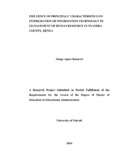| dc.description.abstract | The purpose of the study was to determine the influence of principals’
characteristics on integration of information communication technology in
management of human resources in Nyamira County Kenya. The study sought to
investigate the following objectives. to establish the influence of principals’
exposure to training in ICT, to establish the principals’ level of education and to
determine the influence the principals’ age and the influence of gender on ICT
integration. The theory that was used was the systems theory which enables us to
understand the interplay between individual and institutional factors on
integration of ICT in human resource management. The study used descriptive
survey with a target population of 90 secondary school principals, 600 teachers
and 30 chairpersons of board of management of secondary schools in Nyamira
County. Out of whom 30 principals, 180 teachers and 30 board of management
chairpersons were sampled using stratified proportionate sampling because the
schools were stratified into category and type. The data collection tools were
questionnaires for principals and teachers and interview schedule for board of
management. The data was analyzed according to themes and objectives.
Quantitative data was entered into the computer for analyzing using statistical
package for social science (SPSS). The study revealed that principals’ exposure is
in consistent to ICT integration in management of human resources in public
secondary schools in Nyamira County. Teachers’ level of education showed
inconsistency patterns between teachers level of education and ICT usage. Gender
showed consistency in ICT integration in human resource management. Where 55
percent were male while 45 percent were female, these could be because male
teachers and female teachers regard computer technology as male domain. Also
age bracket 30-49 years showed high percentage respectively that principals
integrate ICT than 50-60 years who had received their training before the
introduction of ICT in the syllabus. Many schools were located in rural areas with
74.7 percent had not embraced ICT on integration of ICT in human resource
management. Most of the teachers had trained early before the introduction of
ICT. This led to the schools facing many challenges on ICT integration
inadequate facilities 29.6 percent, computer breakdown 14.8 percent, inadequate
funds 14.8 percent. This recommends that school principals should mobilize
resources to increase the number of computers in schools that was 63 percent and
train teachers on ICT as per the finding which was 11.1 percent and construction
of computer laboratories which was 25.9 percent of the respondents. Teachers
should change their attitude of 7.4 percent towards the use and integration of ICT
in the in all aspects or teaching and learning institutions so as to achieve vision
2030 nationally. Female teachers should be encouraged to use ICT integration
into human resource management. In conclusion its evident that demographic
factors influence integration of information communication technology | en_US |

